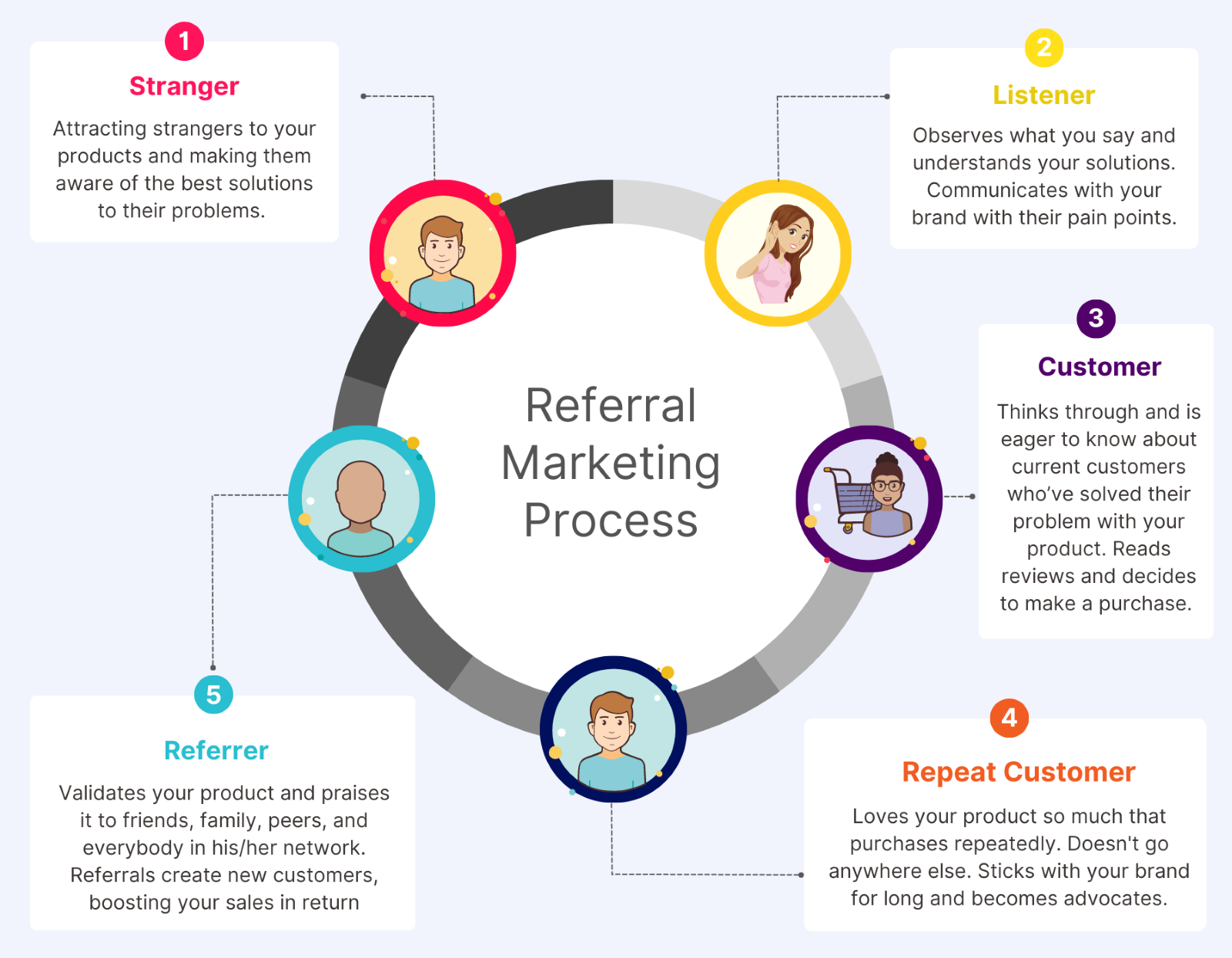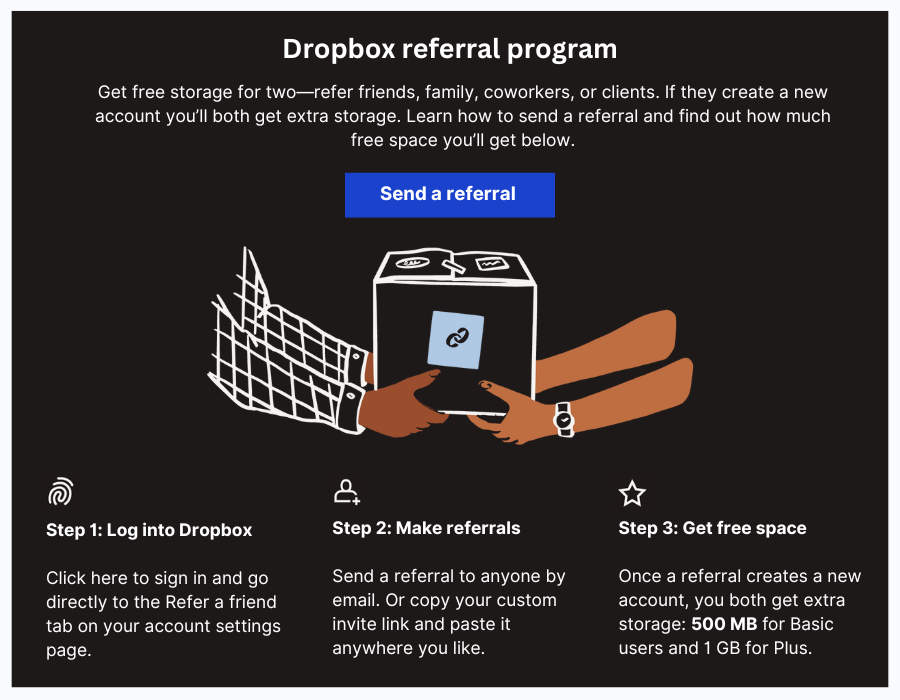Guía única de marketing de recomendación con estrategias
El marketing de recomendación es una de las formas más rentables de fidelizar clientes. Esta guía desglosa las estrategias ganadoras y muestra cómo Xoxoday Plum le ayuda a automatizar, personalizar y ampliar su programa de referidos con las recompensas adecuadas.
En esta página
- ¿Qué es el marketing de recomendación?
- ¿Cómo funciona el marketing de recomendación?
- Beneficios del marketing de recomendación: 10 razones por las que son eficaces
- Tipos de programas de marketing de recomendación
- 7 estrategias de marketing de recomendación que pueden generar clientes potenciales valiosos
- How to create a referral marketing program?
- Referral rewards program best practices
- Consejos para crear un exitoso programa de marketing de recomendación
- Reflexiones finales
A brand reaches its pinnacle when it becomes part of everyday language. Think of Google—what began as a search engine is now a verb for searching. The same goes for Band-Aid, Kleenex, and Jacuzzi. That level of cultural adoption is every brand’s dream—success that goes beyond sales to universal recognition.
But getting there takes time, consistent marketing, and relentless effort. While today’s tools offer many ways to promote your brand, referral marketing remains one of the most powerful—and cost-effective—ways to grow. After all, nothing beats the credibility of a recommendation from a satisfied customer.
The birth of ‘airbnbing’ was simple—the idea was to get people to stay in a neighborhood flat overnight or to borrow a family’s rollaway bed during travel. With this simple intention in mind, they increased their guest arrivals from just 21000 (in 2009) to a whopping 1+ billion (in 2021). (Source: AirBnB)
So how did this born-out-of-necessity business make its entire way to fame? Or perhaps, what made Airbnb a billion-dollar business?
Any guesses? Well, it's because of a well-planned, well-timed, and well-executed ‘referral marketing program.’
Referral marketing is one of the most cost-effective growth channels for a business. Period.
Para ayudarle a sacar el máximo partido de esta estrategia de marketing, hemos elaborado una guía detallada que explica los aspectos básicos del marketing de recomendación, las lecciones que debe aprender de las grandes marcas, los errores que debe evitar, consejos para crear un programa de recomendación de éxito y mucho más.
¿Qué es el marketing de recomendación?
Referral marketing is a strategy that leverages loyal customers and advocates to promote a brand within their network in exchange for rewards. It involves using the influence of referrers—whether individuals or influencers—to generate awareness and drive engagement, either through one-to-one recommendations or broader one-to-many outreach, ultimately leading to increased sales and brand trust.
¿Cómo funciona el marketing de recomendación?
Una persona remite tus productos o servicios a sus amigos, familiares, audiencia (en el caso del marketing de influencers), contactos, etc. El referido compra dicho artículo o servicio para que el proceso finalice con éxito.
Let’s understand referral marketing with a real-life scenario. Let’s assume that you want to buy a brand-new washing machine. Right after exploring some options, you’ll check out all the customer reviews on the internet and might even ask your friend (who bought that product before) to share his/her experiences with the brand.
Tu amigo valida entonces el producto, te asegura que es un gran producto, te convence y te persuade para que realices la compra.
Eso es el marketing de recomendación en pocas palabras.

El marketing de recomendación tiene efectos similares al boca a boca, pero la única diferencia es que la empresa lo inicia y lo gestiona.
This works because consumers tend to trust businesses more after getting a recommendation from another person, especially if it’s someone close.
Beneficios del marketing de recomendación: 10 razones por las que son eficaces
Referral programs are ideal for businesses as they make existing customers feel valued and encourage them to share the brand with their network.
Estas son algunas de las principales ventajas del marketing de recomendación:
1. Aprovecha la influencia entre iguales
In the era of consumerism, shoppers seek product advice from individuals who are already on their friends list. Here, referrals WOMM (Word of Mouth Marketing) wields power over a significant slice of the market. Therefore, referral marketing is the only superior tool to change buyers' thoughts and overcome their cynical scorn for salesy outreach.
2. Aumenta la tasa de retención de clientes
To go after a market that is new to your product, there is a need for more marketing money, marketers, and even more effort. The overheads are often sky-high, making brands question if it’s worth at all prioritizing new consumers over existing ones.
While it’s something to be debated, marketers are already sitting on a heap of opportunities because referrals can take your value proposition to the uninitiated without costing.
3. Menor tiempo de comercialización
Cuando el marketing convencional encuentra un escollo, es porque tiene menos inercia. Carece de la capacidad de persuasión necesaria para cautivar a una parte mayor del mercado en un tiempo limitado. En cambio, las campañas de recomendación pueden desarrollarse y aplicarse en el menor tiempo posible porque no implican necesariamente embudos y marcos sofisticados.
¿Cuál es la ventaja? Los clientes que se consideren inadecuados para el personaje de ventas pueden quedar exentos de la campaña. Cuando no se pierde tiempo persiguiendo a clientes que quizá nunca vuelvan, se exploran oportunidades aún más interesantes.
4. Aumenta el conocimiento de la marca
Como se llama marketing boca a boca, no es difícil darse cuenta de que la gente va a mejorar el conocimiento de la marca hablando de su empresa a otras personas. Incluso el porcentaje que no se convierta conocerá su empresa, continuando así la cadena de conversaciones.
5. Más defensores de la marca
Driving customer advocacy is crucial due to utter social distrust of businesses and marketing. Of course, no business will tell you their products are flawed. But having live people vouch for a brand, praising it, and recommending the right items and services are what most potential buyers are looking for.
6. Mejor CLV (valor de vida del cliente)
Un cliente referido está predispuesto a volver y, además, es posible que se convierta en una referencia para otro. Aportan tanto valor a una empresa que, de media, un consumidor recomendado paga entre un 15 % y un 25 % más en su transacción inicial.
7. Reduce el CAC (Coste de Adquisición de Clientes)
Los clientes recomendados suelen ser más baratos para la empresa que los completamente nuevos. Los costes incluyen las recompensas a los clientes existentes (que también suelen ser rentables), el número de empleados que trabajan en el programa, así como la tecnología de recomendación de clientes.
8. Fácil de incentivar el comportamiento de referencia
Hacer un seguimiento de los referidos es una forma inestimable de ver qué los convierte en una marca de fuego. La información obtenida mediante la investigación del comportamiento de los referidos es suficiente para decidir qué cestas y experiencias a medida son más pertinentes. Esto les daría el impulso necesario para encabezar la promoción.
9. Mayor ROI y menores gastos
Fusionar el marketing de recomendación con las recompensas de fidelización producirá un gran efecto sinérgico que reducirá en gran medida los gastos generales y el tiempo. Porque crear y gestionar un programa de recompensas es menos caro que publicar anuncios en Facebook o Google PPC. El marketing de recomendación ha demostrado en repetidas ocasiones cómo las recomendaciones sociales impulsan la acción de los clientes sólo con recompensas como zanahoria.
Tipos de programas de marketing de recomendación
The beauty of referral marketing is that there are several ways to satisfy consumers, partners, and employees to encourage referral behavior. These are four common methods of referral marketing to increase their revenue.
1. Referencias directas (boca a boca)
El tipo de recomendación más óptimo en el que confían las empresas es la recomendación directa. Se trata de un consumidor muy motivado que no sólo conoce el producto, sino que también aprecia sus ventajas. Son capaces de persuadir a sus compañeros y a cualquier persona a su alcance para que se conviertan en nuevos consumidores.
It does not need large-scale promotion but rather depends on consumers' faith in their peers who are early adopters.
2. Remisiones por correo electrónico
Los profesionales del marketing llevan años utilizando los correos electrónicos de recomendación para captar posibilidades dentro de su red actual. Para ello, identifican a los suscriptores que pueden dar fe de la marca y les envían correos electrónicos con recompensas. Los correos electrónicos no tienen por qué ajustarse a normas específicas, sino que pueden ser comunicaciones breves y directas que posicionen a la marca como impulsora de valor en la red.
3. Remisión de reseñas
¿Sabía que hoy en día la mayoría de las decisiones de compra se toman basándose en opiniones? Las búsquedas locales sobre productos y servicios ayudan a los compradores a decidir si la marca cumple sus expectativas.
Las marcas que conocen la importancia de la gestión de la reputación hacen lo necesario para asegurarse una opinión favorable ante el público. Las marcas que no se toman en serio este ejercicio corren el riesgo de perder clientes potenciales en favor de sus competidores.
4. Referencias en las redes sociales
¿Sabía que hoy en día la mayoría de las decisiones de compra se toman basándose en opiniones? Las búsquedas locales sobre productos y servicios ayudan a los compradores a decidir si la marca cumple sus expectativas.
7 estrategias de marketing de recomendación que pueden generar clientes potenciales valiosos
Ahora, aquí está la gran pregunta: Cómo crear un programa de recomendación que cree chispa y encienda el fuego a la vez que fomenta el compromiso de los clientes. Pues bien, todo empieza y termina con la aplicación de las estrategias de marketing de recomendación adecuadas. A continuación le presentamos algunas de las que debe tomar nota.
1. Enviar mensajes de correo electrónico personalizados
Targeted emails are more relevant to the recipient, increasing the likelihood of taking an action. By tailoring your message to their interests and needs, you can make your referral program more appealing and encourage them to share it with their network.
2. Establezca un buen programa de recompensas
A strong rewards program can turn customers into brand advocates, driving referrals and conversions when aligned with your goals and audience.
Ask yourself: Who are your top customers? What rewards would motivate them to refer others? Should both parties be rewarded? Offering the right incentives—like tiered rewards, e-gift cards, or branded swag—can boost participation and reduce hesitation. Starting small and scaling up with bigger rewards helps keep engagement high.
3. Ofrecer incentivos de doble cara
Las recompensas de doble cara crean una situación en la que ambas partes salen ganando. El recomendante recibe una recompensa por su recomendación, y la persona recomendada recibe una recompensa por probar su producto o servicio. Esto puede ayudar a crear relaciones positivas con ambas partes y aumentar la fidelidad a su empresa.
An example of double-sided rewards is Dropbox’s referral program. The company offers both the referrer and the referred person 500 MB of extra storage space on every successful referral.

This creates a win-win situation, as the referrer receives additional storage space for their referral while the referred person receives additional storage space for trying out Dropbox's service.
4. Calcula bien el tiempo de tu campaña de recomendación
Even if you have a terrific marketing plan and the greatest minds executing it, things can still go wrong if your timing is terrible. That’s why finding the precise moments to pitch your referral program in the user journey is important.
Programar su programa de recomendaciones también puede ayudarle a probar y optimizar el programa a lo largo del tiempo. Si lanza el programa en diferentes momentos y realiza un seguimiento de la participación y los índices de recomendación, podrá identificar el momento más eficaz para el programa y realizar los ajustes necesarios.
Alternatively, try pitching referrals to customers when they make regular purchases or engage positively with your brand (subscribing to your newsletter, sharing your products on social platforms, etc.)
5. Make the participation process seamless
¿Le gustaría una página web que se cuelga o se atasca al reclamar sus recompensas? ¿O una página web que sea rápida, fluida y que le evite procesos manuales y mundanos para reclamar sus recompensas por recomendación? La respuesta es obvia, ¿verdad?
Por otro lado, su programa de recomendación no debería añadirse al montón de tareas que su equipo ya tiene en el día a día. Imagínese, ¿revisar y aprobar uno por uno a los ganadores de las recompensas? Por eso es esencial que todo el proceso sea fácil e intuitivo.
6. Leverage templates to design your referral landing page
Cuando un usuario hace clic en el enlace de recomendación, se le redirige a una página de destino de recomendación en la que se describe todo lo relacionado con el programa. Una página de aterrizaje permite a los usuarios entrar en más detalles, como los términos y condiciones, las recompensas que se ofrecen, los beneficios, etc.
Por lo tanto, es fundamental que sea distintiva y atractiva. La página debe tener como objetivo persuadir a los visitantes para que se inscriban en su programa de recomendación, ayudándoles a convertirse en recomendadores o defensores de la marca.
7. Promote the program on social media
Promocionar su programa de recomendación en las redes sociales es una forma estupenda de llegar a un público más amplio y aumentar la participación en el programa. Cree publicaciones en las redes sociales que destaquen las principales ventajas de su programa de recomendación.
Utilice imágenes llamativas y pies de foto atractivos para captar la atención de sus seguidores y animarles a participar. Además, utiliza hashtags relevantes en tus publicaciones en redes sociales para aumentar la visibilidad.
8. Use chatbots to get the word out
Los chatbots pueden enviar recordatorios automatizados o invitaciones para mantener a sus clientes al tanto de su programa de recomendación y, al mismo tiempo, animarles a que recomienden a sus amigos.
Los chatbots pueden explicar fácilmente las ventajas de su programa de recomendación que pueden recibir los defensores de la marca. A diferencia de los correos electrónicos de recomendación y los anuncios en sitios web, los bots simplifican las cosas. Su naturaleza conversacional les permite comercializar sin esfuerzo y de forma no intrusiva.
How to create a referral marketing program?
Now that you know the importance of referrals and what a powerful tool referral marketing programs are, how can you create a successful one yourself? Here’s the simple three-step process to create a rewards-driven referral program.
1. Identify your happy and satisfied customers
This can be done in a number of ways, but the most effective method is by creating customer surveys. The Net Promoter Score survey is the best way to find the Promoters in your existing customers - people who are highly likely to recommend you to their friends and family.
But you can also use other survey methodologies such as Customer Satisfaction Surveys to find your best advocates.
2. Cultivate and invest in your advocates
Once you’ve selected those promoters and advocates from your existing customers, it’s time to put in the work to truly delight them. It’s about more than just ensuring you’re meeting their expectations - you need to exceed them at every step of the customer experience.
Delight them whenever you can. And do all of this before you ask them for anything so they have a completely positive view - stepping straight into a give-to-get scenario will turn them off because it feels too immediately transactional.
3. Encourage them to recommend your business
Now we get to the ask - it’s time to request that customers join your referral marketing program. You can make this request while offering a variety of rewards, either as a thank you for joining, a reward for a referral, or a combination.
The rewards you offer when you ask customers to refer you can vary depending on the specifics of your program. But there are plenty of software options out there on the market that make this process simple and streamlined, like Plum.
Referral rewards program best practices
There’s no one-size-fits-all approach to referral rewards depending on your customers, what motivates them, and your industry. Still, following best practices can help your program succeed and support business growth.
1. Make sharing simple
Your referral program could have the most incredible awards ever available to your advocates and still fail for one simple reason - the way you ask customers to share their referrals is too complicated.
Even your most dedicated advocates have lots of other things to do in their lives. They’re not going to spend an hour - or even 20 minutes - just figuring out how to send a referral to a friend. They’ll give up and move on to something else.
2. Add a customer loyalty program
One great way to reward customers is to make them feel valued and appreciated for being loyal to your company. A customer loyalty program is the perfect way to do this. Customers who feel recognized and appreciated are more likely to recommend and refer friends and family to your business.
Sephora is a good example of a retailer that rewards their best customers well. With every purchase, their Beauty Insiders can earn points and redeem them for different levels of rewards, from small gifts to full-size beauty products to exceptional brand experiences.
3. Think like a customer
Referral marketing programs are so effective for growing businesses that it’s easy to just focus on how they will benefit from creating a referral system. But that’s the opposite of what referral incentives are really all about - you need to think first about what your loyal customers and advocates actually want and respond to.
You shouldn’t guess or assume that you already know. Instead, try conducting customer surveys to see what they value most and testing your program options as you launch.
4. Use referral rewards software
Managing a referral rewards program through your own marketing team is very time-consuming. Finding the right partner or the perfect referral rewards software to help you deliver those referral rewards the right way is a good investment of your marketing dollars to make your program as effective as possible.
Look for one that integrates effortlessly with your existing referral tools to make your rewards system simple. And don’t forget to select a system that lets you reward brand advocates for more than simply purchases, but for referrals and shout-outs on social media channels as well.
Consejos para crear un exitoso programa de marketing de recomendación
He aquí algunos consejos para que su programa de marketing de recomendación funcione como un motor bien engrasado:
- Offer a valuable incentive: The reward you offer must be valuable enough to motivate your customers to refer their friends. Make sure to give something that your customers actually want and can use.
- Make it easy to participate: The referral process should be easy and straightforward. Your customers should be able to refer their friends with just a few clicks or taps.
- Personalize your invitations: Personalized invitations can be more effective in motivating customers to refer their friends. Segment customers based on demography while giving a glimpse of what they will get as a reward if they referred someone.
- Use multiple channels to promote your program: Promote your referral program through various channels, such as email, social media, and your website. This can increase the visibility of your program, helping your brand reach a wider audience.
- Provide real-time feedback: Keep your customers informed about the status of their referrals. Let them know when their friends have signed up or made a purchase. This can increase their engagement and motivation to participate in the program.
- Measure and optimize: Monitor the performance of your referral program and track metrics such as referral rate, conversion rate, and customer lifetime value. Use this data to optimize your program and make improvements.
- Time your referral requests strategically: Timing is important in referral marketing. Make sure you request referrals at the right time.
Reflexiones finales
Referral marketing isn’t just a growth tactic—it’s a trust-driven strategy that turns your happiest customers into your most powerful advocates. Referred customers are not only more loyal but also more valuable in the long run, all while reducing your acquisition costs compared to traditional marketing efforts.
But to make referrals truly work, you need more than just a good strategy—you need great execution. That means a product worth sharing, standout customer service, and a reward system that motivates people to spread the word.
If you’re looking for a simple, powerful way to set up your referral rewards program software, look no further than Plum. It offers everything you need to turn your customers into your brand ambassadors with the right rewards.
Want to learn more?
Book your demo today.


















